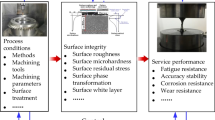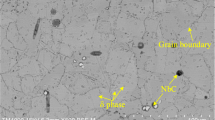Abstract
Ultra-precision grinding, wire-cut electro discharge machining and lapping are often used to machine the tools in fine blanking industry. And the surface integrity from these machining processes causes great concerns in the research field. To study the effect of processing surface integrity on the fine blanking tool life, the surface integrity of different tool materials under different processing conditions and its influence on fatigue life were thoroughly analyzed in the present study. The result shows that the surface integrity of different materials was quite different on the same processing condition. For the same tool material, the surface integrity on varying processing conditions was quite different too and deeply influenced the fatigue life.
Similar content being viewed by others
References
P. Gruber et al., High-strength steel under monotonic and cyclic loading–A study on the damage evolution near the edge of a stamping tool, BHM Berg-und Hüttenmännische Monatshefte, 154 (5) (2009) 205–210.
K. Ho and S. Newman, State of the art electrical discharge machining (EDM), International Journal of Machine Tools and Manufacture, 43 (13) (2003) 1287–1300.
C. Huang, C. Hsu and H. Kuo, The surface characteristics of P/M high-speed steel (ASP 23) multi-cut with wire electrical discharge machine (WEDM), Journal of Materials Processing Technology, 140 (1) (2003) 298–302.
K. T. Chiang and F. P. Chang, Optimization of the WEDM process of particle-reinforced material with multiple performance characteristics using grey relational analysis, Journal of Materials Processing Technology, 180 (1) (2006) 96–101.
M. Shabgard et al., A Experimental investigation and 3D finite element prediction of the white layer thickness, heat affected zone, and surface roughness in EDM process, Journal of Mechanical Science & Technology, 12 (2011) 3173–3183.
F. Klocke, D. Welling and J. Dieckmann, Comparison of grinding and wire EDM concerning fatigue strength and surface integrity of machined Ti6Al4V components, Procedia Engineering, 19 (2011) 184–189.
M. DeVries, M. Field and J. Kahles, Relationship of surface roughness and surface integrity to functional properties, Annals of the CIRP, 25 (2) (1976) 569–573.
R. M'Saoubi et al., A A review of surface integrity in machining and its impact on functional performance and life of machined products, International Journal of Sustainable Manufacturing, 1 (1) (2008) 203–236.
I. Jawahir et al., Surface integrity in material removal processes: Recent advances, CIRP Annals-Manufacturing Technology, 60 (2) (2011) 603–626.
Y. Guu and H. Hocheng, Improvement of fatigue life of electrical discharge machined AISI D2 tool steel by TiN coating, Materials Science and Engineering: A, 318 (1) (2001) 155–162.
F. Hashimoto, Y. B. Guo and A. W. Warren, Surface integrity difference between hard turned and ground surfaces and its impact on fatigue life, CIRP Annals-Manufacturing Technology, 55 (1) (2006) 81–84.
X. Huang et al., Experimental study on white layers in high-speed grinding of AISI52100 hardened steel, J. Mech. Sci. Technol., 29 (3) (2015) 1257–1263.
M. Gostimirovic et al., Influence of discharge energy on machining characteristics in EDM, Journal of Mechanical Science & Technology, 26 (1) (2012) 173–179.
A. Gholipoor, H. Baseri and M. R. Shabgard, Investigation of near dry EDM compared with wet and dry EDM processes, Journal of Mechanical Science & Technology, 29 (5) (2015) 2213–2218.
K. K. Choi, W. J. Nam and Y. S. Lee, Effects of heat treatment on the surface of a die steel STD11 machined by WEDM, Journal of Materials Processing Technology, 201 (1) (2008) 580–584.
V. G. Navas et al., Electro-discharge machining (EDM) versus hard turning and grinding—Comparison of residual stresses and surface integrity generated in AISI O1 tool steel, Journal of Materials Processing Technology, 195 (1) (2008) 186–194.
M. Baklouti, R. Mnif and R. Elleuch, Impact of surface hardening treatment generated by shot peening on the fatigue life of brass alloy, Journal of Mechanical Science & Technology, 26 (9) (2012) 2711–2717.
S. Smith et al., Effect of surface integrity of hard turned AISI 52100 steel on fatigue performance, Materials Science & Engineering A, 459 (1) (2007) 337–346.
Author information
Authors and Affiliations
Corresponding author
Additional information
Recommended by Associate Editor Dae-Cheol Ko
XiangLin Zhang is a Professor in Department of Materials Science and Engineering. He received his Ph.D. in Materials Processing Engineering from Huazhong University of Science and Technology, China in 1995. His research interests include fine blanking and biological bone tissue engineering.
Rights and permissions
About this article
Cite this article
Cao, C., Zhang, X. Effect of different machining processes on the tool surface integrity and fatigue life. J Mech Sci Technol 30, 3785–3792 (2016). https://doi.org/10.1007/s12206-016-0740-2
Received:
Revised:
Accepted:
Published:
Issue Date:
DOI: https://doi.org/10.1007/s12206-016-0740-2




